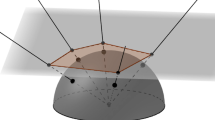Abstract
Lemke's algorithm for the linear complementarity problem follows a ray which leads from a certain fixed point (traditionally, the point (1,⋯, 1)T) to the point given in the problem. The problem also induces a set of 2n cones, and a question which is relevant to the probabilistic analysis of Lemke's algorithm is to estimate the expected number of times a (semi-random) ray intersects the boundary between two adjacent cones. When the problem is sampled from a spherically symmetric distribution this number turns out to be exponential. For ann-dimensional problem the natural logarithm of this number is equal to ln(τ)n+o(n), whereτ is approximately 1.151222. This number stands in sharp contrast with the expected number of cones intersected by a ray which is determined by two random points (call itrandom). The latter is only (n/2)+1. The discrepancy between linear behavior (under the ‘random’ assumption) and exponential behavior (under the ‘semi-random’ assumption) has implications with respect to recent analyses of the average complexity of the linear programming problem. Surprisingly, the semi-random case is very sensitive to the fixed point of the ray, even when that point is confined to the positive orthant. We show that for points of the form (ε, ε 2,⋯, ε n)T the expected number of facets of cones cut by a semi-random ray tends to 1/8n 2+3/8n whenε tends to zero.
Similar content being viewed by others
References
I. Adler, “The expected number of pivots needed to solve parametric linear programs and the efficiency of the Self-Dual Simplex method”, Technical Report, Department of Industrial Engineering and Operations Research, University of California (Berkeley, CA, June 1983).
I. Adler and N. Megiddo, “A simplex algorithm whose average number of steps is bounded between two quadratic functions of the smaller dimension”, in:Proceedings of the 16th Annual ACM Symposium on Theory of Computing (ACM, New York, 1984). Also:Journal of ACM, to appear.
I. Adler, N. Megiddo and M.J. Todd, “New results on the average behavior of simplex algorithms“,Bulletin of the AMS 11 (1984) 378–381.
G.B. Dantzig,Linear programming and extensions (Princeton University Press, Princeton, NJ, 1963).
B.C. Eaves and H. Scarf, “The solution of systems of piecewise linear equations“,Mathematics of Operations Research 1 (1976) 1–27.
M. Haimovich, “The simplex algorithm is very good!—On the expected number of pivot steps and related properties of random linear programs”, manuscript, Columbia University (New York, NY, April 1983).
R. Howe, “Linear complementarity and the average volume of simplicial cones”, Cowles Foundation Discussion Paper No. 670, Yale University, (New Haven, CT, June 1983).
K.G. Murty, “Computational complexity of complementary pivot methods“,Mathematical Programming Studies 7 (1978) 61–73.
R. Saigal, “On some average results for random complementarity problems”, Technical Report, Department of Industrial Engineering, Northwestern University (Evanston, IL, June 1983).
S. Smale, “On the average number of steps of the simplex method of linear programming“,Mathematical Programming 27 (1983) 241–262.
S. Smale, “The problem of the average speed of the simplex method”, in: A. Bachem, M. Grötschel and B. Korte, eds,Mathematical programming: The state of the art (Springer-Verlag, 1983) pp. 530–539.
M.J. Todd, “Polynomial expected behavior of a pivoting algorithm for linear complementarity and linear programming problems”, Techical Report No. 595, School of Operations Research and Industrial Engineering, Cornell University (Ithaca, NY, November 1983).
Author information
Authors and Affiliations
Additional information
This work was done while the author was visiting Stanford University and XEROX-PARC and was supported in part by the National Science Foundation under grants MCS-8300984, ECS-8218181 and ECS-8121741.
Rights and permissions
About this article
Cite this article
Megiddo, N. On the expected number of linear complementarity cones intersected by random and semi-random rays. Mathematical Programming 35, 225–235 (1986). https://doi.org/10.1007/BF01580648
Received:
Revised:
Issue Date:
DOI: https://doi.org/10.1007/BF01580648



